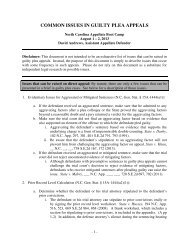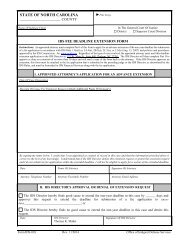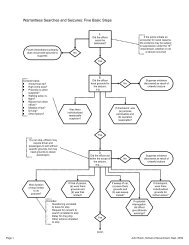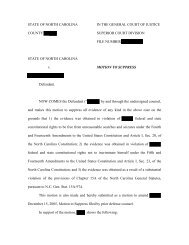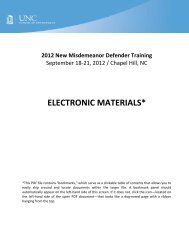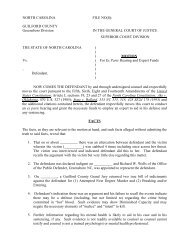a Ten-Step Guide to CLOSING ARGUMENT
a Ten-Step Guide to CLOSING ARGUMENT
a Ten-Step Guide to CLOSING ARGUMENT
- No tags were found...
You also want an ePaper? Increase the reach of your titles
YUMPU automatically turns print PDFs into web optimized ePapers that Google loves.
file:///H|/PUBLIC/Defender Training/Trial School/2006/Materials/15 Closing Argument -- Kelly.htmThe new <strong>to</strong>uchs<strong>to</strong>ne in trial practice is s<strong>to</strong>rytelling and I am one of its avid disciples. However, I amconvinced that the best s<strong>to</strong>ryteller will fail <strong>to</strong> persuade the jury if s/he uses closing argument only as anopportunity <strong>to</strong> tell a s<strong>to</strong>ry. A s<strong>to</strong>ry <strong>to</strong>ld well may hold the jurors' interest and even entertain them, but ifthe lawyer fails <strong>to</strong> explain why it matters <strong>to</strong> their verdict, in the end, the lawyer will still lose. For thatreason, I encourage you <strong>to</strong> think of a good closing argument not as a single s<strong>to</strong>ry, but as a wellorganizedpho<strong>to</strong> album; each page of vivid, vibrant pho<strong>to</strong>graphs carefully attached in its appropriateplace beside a succinct, running commentary. The commentary points out the significance of andsubtleties within each pho<strong>to</strong>graph that might easily be missed or overlooked by the casual observer.The pho<strong>to</strong>graphs in your closing argument are the vignettes and scenes carefully culled from theevidence and vividly painted for your jurors through the skills of s<strong>to</strong>rytelling <strong>to</strong> prove a point. Themoment your innocent client learns he's falsely accused and yet does not run away is a pho<strong>to</strong>graph thatsupports his innocence. The harsh reality of an interrogation room is a pho<strong>to</strong>graph which explains whythe confession does not match the physical evidence and is therefore not believable. Each of these scenesmust be brought <strong>to</strong> life again for the jurors during your argument through the skill of s<strong>to</strong>rytelling. Yetthey do not and cannot stand alone. Without benefit of an accompanying commentary, a carefullycraftedexplanation of how each of these events fit <strong>to</strong>gether <strong>to</strong> paint a picture of innocence, you run thevery real risk that your jurors may never understand the significance of or subtleties within yourpho<strong>to</strong>graphs. Absent that understanding, the likelihood they will reach the conclusion you want them <strong>to</strong>reach is a risk no gambler would want <strong>to</strong> take.Of course, the opposite extreme is equally ineffective. The perusers of our proverbial pho<strong>to</strong> album willquickly lose interest in the most thorough of commentaries if there are no pho<strong>to</strong>graphs <strong>to</strong> accompany it!A dry exposition on how the evidence supports a finding of not guilty does not move us, capture ourattention or imagination, or make us care. BOTH vivid pho<strong>to</strong>graphs (s<strong>to</strong>rytelling) and carefully craftedcommentary (argument) are critical <strong>to</strong> an effective closing. Equal attention must be paid <strong>to</strong> both.file:///H|/PUBLIC/Defender Training/Trial School/2006/Materials/15 Closing Argument -- Kelly.htm (13 of 13)6/28/2006 12:35:33 PM






